Visiting the set of The Predator
Last year, we headed over to Vancouver to see how Shane Black's getting on with The Predator. Here's what happened...
When director John McTiernan headed off into the steamy Central American jungle about 30 years ago to make Predator, the realism of the setting helped create one of the 1980s’ best action films. The cast and crew may have suffered through injuries, illness and uncomfortable heat, but all of that played into its simple yet effective premise: a bunch of mercenaries stuck in the jungle, hunted and outgunned by an invisible alien hunter.
All being well, the movie should mark a new chapter in the 80s franchise, which from its high point in the Arnold Schwarzenegger vehicle from 87 and a decent 90s sequel starring Danny Glover, was eventually brought low by two disappointing cross-over movies: Alien Vs Predator, directed by Paul WS Anderson in 2004, and Aliens V Predator: Requiem, directed by the Strauss brothers in 2007. The former had a solid enough premise compromised by its PG-13 rating; the latter was brought low by its indifferent direction, bad-taste violence and a crew who apparently forgot to pay the electricity bill.
Hopes are high, then, that Shane Black can put the alien hunter back at the top of the Hollywood food chain where he belongs. As most movie geeks already know, Black and Predator have a long history; a young up-and-coming screenwriter at the time, Black played bespectacled grunt Hawkins in the first movie. (Legend has it that he was hired by Silver so there’d be a screenwriter on set in case any last-minute rewrites were required.)
As he sweated in the fictional jungle of Val Verde – he was the first of the larger-than-life mercenaries to meet a sticky end at the Predator’s blades – the young writer was on the cusp of his major breakthrough. Lethal Weapon, which he wrote and Richard Donner directed, was a massive hit in 1987, further popularising the buddy-cop thriller genre and establishing Black’s style of writing: barbed witticisms, plus the page-turning violence and pacing of a great hardboiled thriller novel.
It seems fitting, then, that Black should circle back to The Predator, which he’s co-written with his old writing partner Fred Dekker, with whom he penned the cult horror comedy Monster Squad back in 1986. Maybe the Predator franchise needs a bit of Black’s magic: irreverence, tension, withering flashes of violence.
Encouragingly, one producer seems confident that The Predator will be prime, uncensored Black: the movie will, he tells us with a grin, be “everything we’d want from an R-rated Predator movie”.
So what exactly does a Predator movie co-written and directed by Shane Black look like?
Here it is in a nutshell: picking up some 30 years after the original, The Predator introduces another group of mercenaries akin to the ones Arnold Schwarzenegger once led. Calling themselves the Lunatics, they’re a bunch of misfit ex-soldiers who somehow find themselves hunted by another alien big game hunter; this time, though, they’re fighting the creature in various parts of the US state of Georgia, including a forest, suburbia, and the interior of a school.
There appears to be an element of conspiracy thriller introduced here, too; the US government are trying to cover up the existence of the Predators. The Predators, meanwhile, appear to have a more complicated agenda of their own: they aren’t here to merely hunt humans, but tinker with our DNA – as Olivia Munn’s scientist character Casey Bracket explains in the first teaser trailer, “I think they’re attempting hybridisation. They’re upgrading on every planet they visit…”
How are they upgrading exactly? Why are they hybridising? Everybody we spoke to last year remained tight-lipped. One small fact we did glean early on, though: in a break from past Black movies, The Predator isn’t set at Christmas, but at Halloween.
“That thing out there’s an assassin”
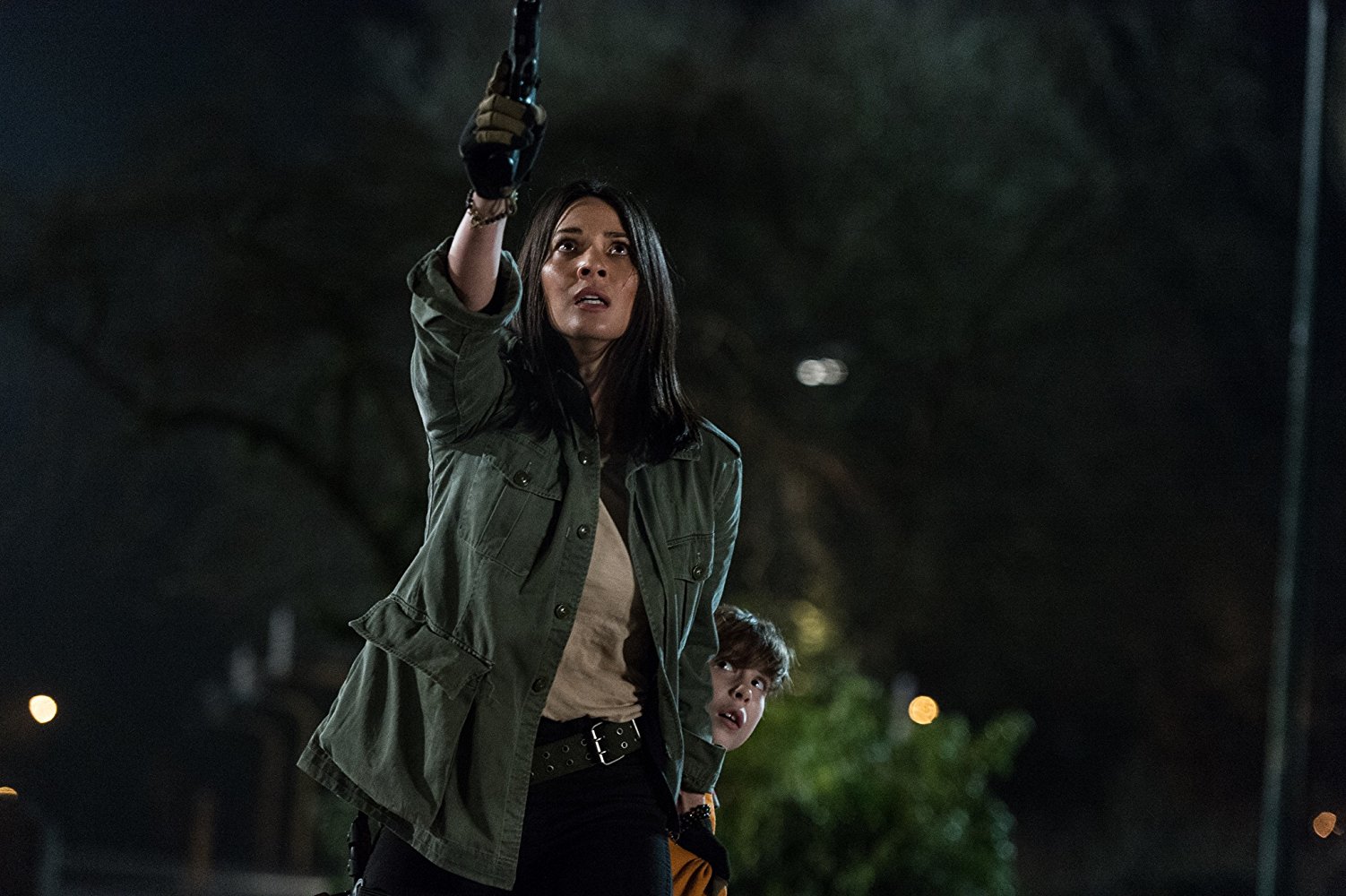
The Predator show is in full swing as we arrive at Mammoth Studios in Vancouver one grey spring morning in April 2017. Inside a vast sound stage, which looks as though it might once have been a distribution warehouse of some kind, an array of sets stand shimmering beneath artificial lights. The most eye-catching of these is a large patch of woodland – our publicist Lorraine calls it “The Swamp” – with vines strewn thickly across pine trees and loamy soil banked up to create little hills. The trees must be at least 30 feet tall, stretching almost all the way to the studio ceiling. The set looks uncannily realistic; part of the ground looks like glistening mud; when we reach out and touch it, we realise it’s some kind of plaster mould, varnished to look slippery and wet.
To the left of the trees sits a patch of rocks and ice; we’re not sure whether it’s part of the same woodland area or whether it’ll be used for close-ups in another sequence. We’re guessing it’s the latter. We’re led through a craft services tent (coffee, tea, cakes, biscuits and Settler’s Tums all on tap) and past what looks like a huge white cocoon sitting on top of a network of scaffolding. This, we’re told, is an alien space ship called The Ark.
For much of the day, we sit in a black tent, bunched together on folding chairs. We can see what’s being filmed on a monitor; the first scene of the day takes place in a school, with the shot taking in a bunch of ordinary-looking lockers sitting against a burgundy wall. It’s a small, simple set, perhaps because it’ll only really be seen from two angles – the one we can see now and a second one where the camera pans round dramatically to reveal someone – or something – tall and shadowy.
In the frame are the film’s three (human) stars. There’s Boyd Holbrook, the Logan villain who plays a much more heroic character here, mercenary Quinn McKenna, leader of the Lunatics. Next to him is Jake Tremblay, the young actor who delivered a stunning performance in the Oscar-nominated Room; he plays Quinn’s son, Rory. Along with them is Olivia Munn (Psylocke in X-Men: Apocalypse), who plays scientist Casey Bracket. We’re not told why they’re in a school, especially while carrying firearms (pistol for Munn, machine gun for Holbrook), but here they are, prowling around expectantly.
It doesn’t take too long to see why they’ve come prepared. Abruptly, a dark figure lunges into frame: a Predator, played by an unfeasibly tall man named Brian.
The sweetest Predator in the galaxy
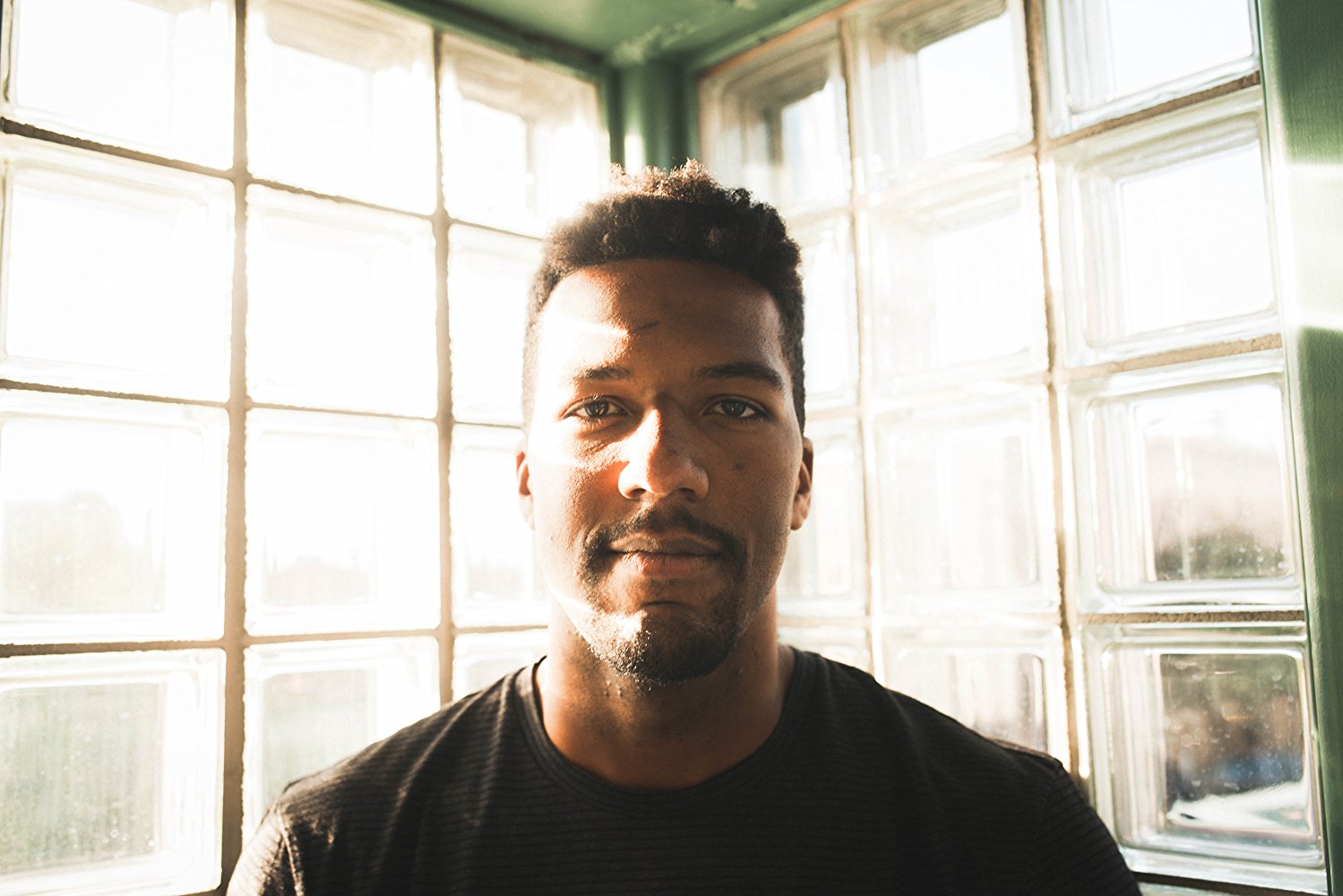
There’s a certain thrill to seeing a Predator in real life. First, there’s the scary height of the thing: about seven feet tall, with the bulky shoulders, the dreadlock-esque head tentacles and that cool, metallic mask. How disconcerting, then, that the guy under the Predator mask is loveable, smiling comic book geek named Brian Prince – it just so happens that he’s a comic book geek who’s nearly seven feet tall and great at parkour.
“Olivia Munn said to me, ‘There’s no way you can play the Predator – you’re too nice,’” Prince says with a huge grin. As Prince says this, he shifts his weight on a tall director’s chair, the wood flexing beneath his muscular bulk. From the head downwards, he’s pure Predator: the pale mottled skin, clawed hands, futuristic body armour. From the neck up, he’s happy 20-something ex student who dreams of one day turning his comic into an animated feature.
“I got really lucky,” Prince shrugs. “I was originally an art student in Atlanta, I draw comics and do illustrations and stuff. I was in Seattle Washington in a parkour gym – I’ve done parkour for nine years.”
All that change, Prince explains, when he got a call from The Predator‘s stunt coordinator; Prince made a video demonstrating his parkour skills, sent it off, and within a few weeks, he was on a plane bound for Los Angeles.
“I just got in there and started swingin’ and jumpin’, started running around. We did the audition process – there was me, Kyle, about three other guys, all about the same height. We drew in our own take of some kind of creature movement. I mixed in some hunting and primal elements with a lot of my parcour movements – a lot of jumping, vaulting, rolling around. I guess Shane liked it, because the next day they told me I got it. I was like, What? I was working minimum wage last year, and now I’m here!”
So how does a friendly artist from Atlanta, Georgia get into the headspace of a ruthless hunter from another planet? Prince’s secret weapon, he explains, is none other than Spotify.
“One thing I started doing a few weeks in was listening to a lot of music – it’s always been easy for me to listen to a song and take the emotion out of it,” Prince says. “This one’s angry, this one’s sad. So I’ve been doing that. I have a playlist on my phone, on my Spotify, and it has a lot of videogame music. Foo Fighters. Pumped up, angry – I called [the playlist] Destroy. I have a lot of stuff from the God Of War games, because that character’s a big inspiration for me. The main character of that game is Kratos – this big, tall warrior. He’s very similar to what the Predator creature is, in my mind, so I use him as a reference and inspiration.”
All that parkour, meanwhile, will go towards creating a more agile Predator than we’ve seen in previous movies. Sure, the monster in the Schwarzenegger classic could lurk in trees and move swiftly, but the 2018 Predator, Prince says, will be far more fleet-footed.
“This creature’s a lot more mobile. In the other films, they’d move, for sure, but a lot of the times, in the first one, there wasn’t a lot of agile movement. So with this one, for me, they’re throwing me through things, I’m fighting, slashing. One of the things I had in mind was for the creature to look heavy, to look big, but also to be very mobile – kind of like a lion. A big creature… or a bear. You see one running at you, and you’re like, Oh damn.”
As the interview draws to a close, Prince continues to marvel at the chance to appear in a big-budget sci-fi movie; he explains that, for the first few days, he didn’t even realise he could just ask somebody for a bottle of water if he felt thirsty in his heavy, stuffy 60lb suit. “I’m learning to be more assertive without being a jerk,” the actor says, his latex alien biceps bulging.
Getting out of his chair, Prince thanks everybody in turn, before heading off to play a deadly alien hunter in another scene. As one journalist puts it: “He’s the sweetest Predator ever.”
Meeting the Lunatics
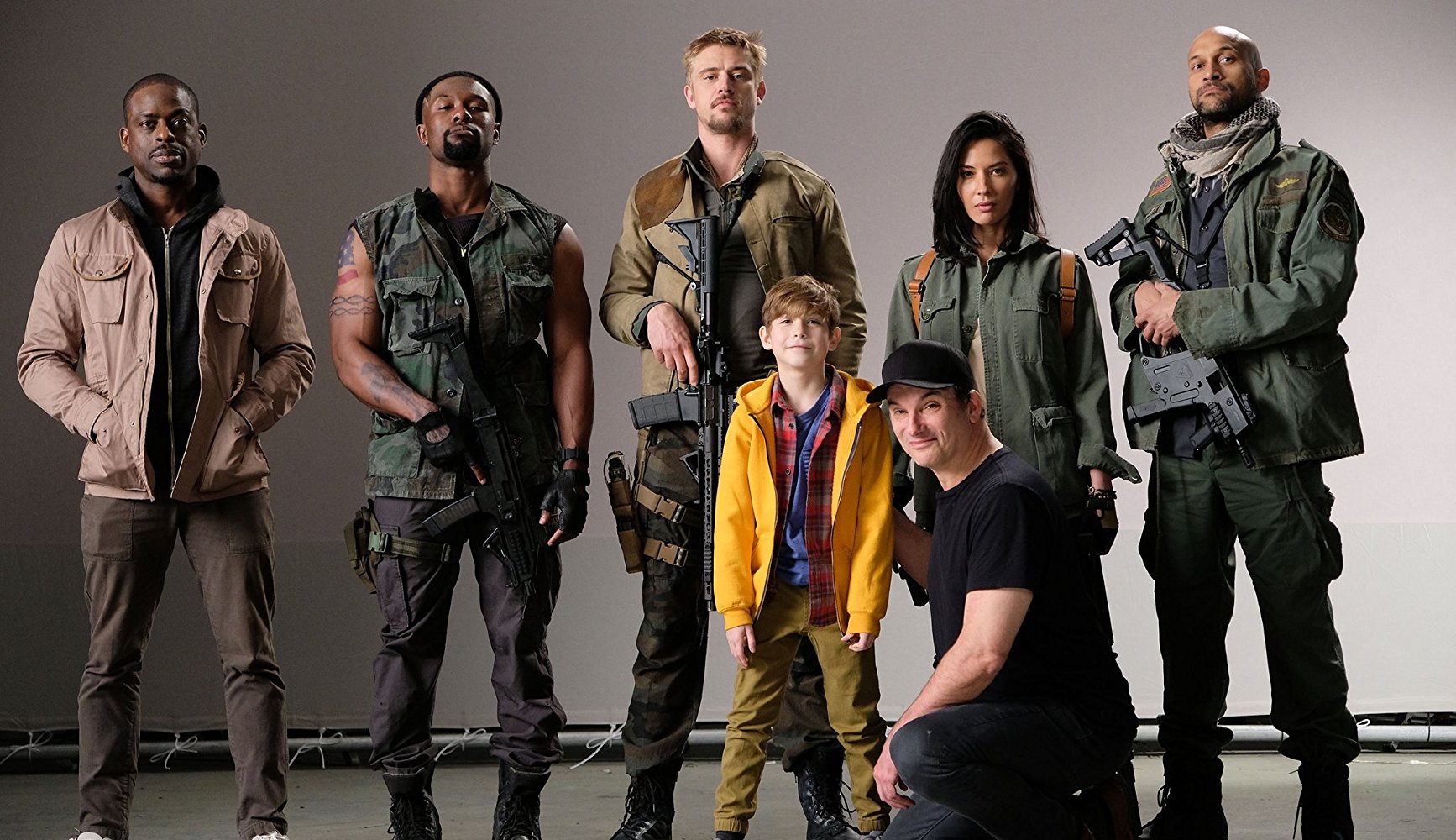
A few minutes later, and Prince is back on set, grasping Boyd Holbrook by the throat. The actors go through their moves, hit their marks, then pause to consult with the crew over how they should move and where they should look. One of the big sticking points for the stunt coordinator, Marny Eng, is that Bryan isn’t pivoting quite right as he grabs Holbrook and slams him up against a window. It takes a few goes of lunging and pivoting before everyone’s happy that the Predator’s moving in just the right way.
Between rehearsals, Munn amuses Tremblay by playing the Star Spangled Banner on an invisible trumpet created with her thumb and forefinger. Holbrook does a few tap-dancing moves, or puffs his cheeks and blows out air to make a gentle raspberry noise. In one rehearsal, the magazine appears to drop out of Holbrook’s prop machine gun.
“You break it, you pay for it,” Tremblay says.
We’re told this is one of the earlier scenes in the film – one that helps establish the relationship between the three leads. Not unlike Black’s earlier movies, The Last Boy Scout (directed by Tony Scott) and The Nice Guys, The Predator will take in a strained and evolving parent-child relationship. Holbrook’s character has spent years as a soldier fighting overseas, which means he’s separated from his wife (played by Yvonne Strahovski) and seldom seen by his son Rory, the child prodigy played by Tremblay.
“He’s estranged from his son, he’s estranged from his wife,” Holbrook says between takes. “And really, Quinn’s journey throughout this story is becoming a leader to these men, the Loonies, becoming a father to my son. That’s his journey, basically.”
It’s Black’s focus on the characters and their relationships, Holbrook says, that will separate The Predator from other expensive blockbusters.
“In this demographic of films, these mega-movies, I feel like there’s been a little bit of phoning it in,” Holbrook tells us. “They’re all becoming this big, long film. I’m not tooting my own horn, but that’s why I was so attracted to a film like Logan, because I felt that it had substance and story, but still fitting in that demographic […]Once I saw there was an element of a true relationship between all the characters, and that Shane was coming on, the kind of film Shane makes, I was ecstatic, I guess you could say.”
Just as Predator was something of a genre mash-up: action, war movie, sci-fi slasher horror and so forth – so 2018’s The Predator will take in elements of action, black comedy, conspiracy thriller and, Holbrook says, western.
“I hadn’t thought of that, but it’s really spot on,” actor Augusto Aguilera says when we ask him whether he thinks The Predator has elements of a western in it. “It’s a Shane Black film, so you know you’re going to get some of that shoot-em-up humour that he’s so good at. But yeah, it does have that western element to it – not that you’re gonna see a Predator in a cowboy hat or anything.”
Aguilera, who you may have seen in shows like Grey’s Anatomy and Chasing Life, plays Nettles: helicopter pilot, younger member of the Loonies and “the runt of the group.”
“I’m trying to be cool like the other guys,” Aguilera says. “I’m always trying to fit in and figure out what we’re doing.”
Like a lot of people we speak to on the set, Aguilera’s a big fan of the original Predator; we get the sense that just about everyone’s excited about the prospect of bringing one of the most memorable monsters of the 80s back to the screen. Even Jacob Tremblay, who’s theoretically much too young to see an R-rated action flick, says he’s sat through all the Predator movies – for research purposes, of course.
“The original one? Yeah, I saw the one with Arnold Schwarzenegger,” Tremblay tells us. “I saw the second one. I’ve seen all the Alien Vs Predators. Once I saw all those, I was really excited to do this movie, because I saw all the aliens and the spaceships, so I was excited to see that stuff in real life. The first one is my favourite. It’s a classic. It’s just because it’s Arnold Schwarzenegger, and he punches the Predator, and outsmarts him, and makes traps. It takes place in the jungle. There’s lots of suspense, and it’s scary – it’s horror.”
“The Predator has always been beautiful”
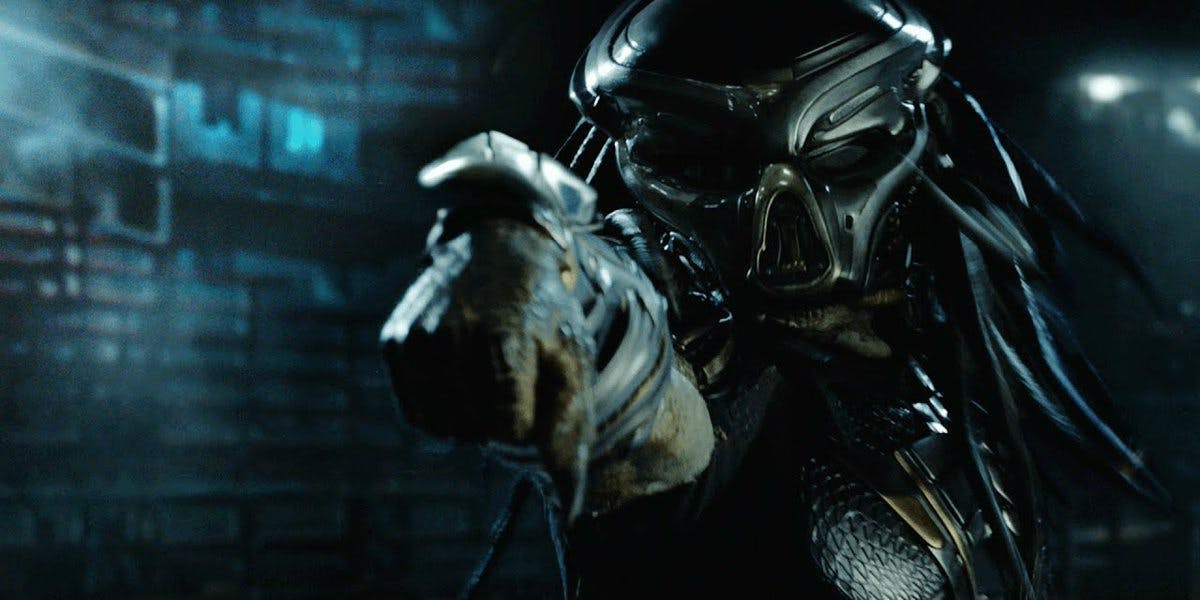
It’s heartening, in an age of ubiquitous computer graphics, that the Predator’s still being brought to the screen largely via practical effects; Amalgamated Dynamic Images (ADI), the company owned by Tom Woodruff Jr and Alec Gillis, are once again handling the animatronics-and-latex side of things.
If their names aren’t already familiar to you, Woodruff and Gillis’s work certainly will: they worked with Stan Winston on the original Predator, and have worked on all the Alien and Predator movies since 1992’s Alien 3 onwards; Gillis was even the guy in the xenomorph suit in Alien 3 and Alien: Resurrection. As they sit down with us in the darkened press tent, their enthusiasm for all things Predator positively bubbles over.
“To us, the Predator has always been beautiful,” says Woodruff – before quickly adding, “not in a weird way, but because we love monsters. And the Predator is one of the coolest monsters ever designed. We were with Stan Winston on the original, so it was nice to have been involved from the very beginning.”
This leads Alec Gillis into an anecdote about the original Predator, and how its original monster was pivoted late in production from Jean Claude Van Damme in a suit to the creature monster fans know today.
“We were in the monster shop. We had just done Aliens… we’d done a few movies for Stan [Winston], and that’s where we met. He came in and said, ‘Guess what guys, it’s a movie called Predator, and it’s in trouble. They don’t like the monster. It’s this guy called Jean Claude Van Damme wearing a suit…’ So Joel Silver and John McTiernan came over. And we were young kids, listening in, and they said, ‘You have six weeks to build the creature…'”
Fortunately, there were no such time pressures this time around, and for Gillis and Woodruff, it’s a chance to revisit one of their favourite movie monsters and bring them to the screen again with their trademark practical effects.
“We’re big fans of practical effects, because we think the real stuff just looks the best,” Woodruff says. “That’s not to say there’s not a place for the digital as well, because there always is. So there are several Predator characters in this movie that are practical, as they should be in our opinion, and we think it’s what the fans want to see: a real Predator standing next to a person.”
There are little clues here and there, however, that not all the creature effects in The Predator will be practical. Later in the day, we see a sequence where a Predator goes flying backwards through a window – likely the same school window we saw Holbrook slammed up against in an earlier scene. It’s a small yet near looking stunt: we see the shot from a low, three-quarter angle as the Predator crashes through the wooden window frame.
Once the camera operators have caught the take, a crew member rushes in with those mirrored ball things that visual effects use to add CG elements to the sequence in post-production. First a mirrored ball is lowered in front of the camera, then a matt one, then a third one textured after the Predator’s skin: that pale, mottled grey with an amphibious, sticky sheen. Finally a prop arm is lowered into view; it’s unmistakably a Predator arm, but huge even by the alien hunter’s standards. Could it be that The Predator of the title isn’t a guy in a suit like the others, but a much bigger one brought to life with CGI? The occasional mention of a “10-foot mutha” certainly suggests that he will be.
Later, we learn that there’ll be three “classic” Predators in the finished film, as well as two new varieties we’ve never seen before. Their tech will be much more advanced than we’ve seen before, too; production Martin Whist describes a new device mounted on a Predator’s gauntlet that it can shoot out and control electronic devices – including his own ship.
Oh, and if you were wondering whether The Predator will match the first two movies in front of the gore, fear not: visual effects supervisor Jonathan Rothbart has some words of reassurance:
“There’s no question that I have a lot of gore to deal with. A lot of blood, both green and red. We try to get as much on set as possible so that we can see it there with the actors, with everybody in it. Just in general, everything plays better in everyone’s eyes as well as in the camera. But then we’ll go back and shoot a series of elements – just stand-alone, blood elements and things like that, along with some digital blood and guts and body parts. We’re not shy on any of it, that’s for sure…”
“I really want to kill him in his sleep”
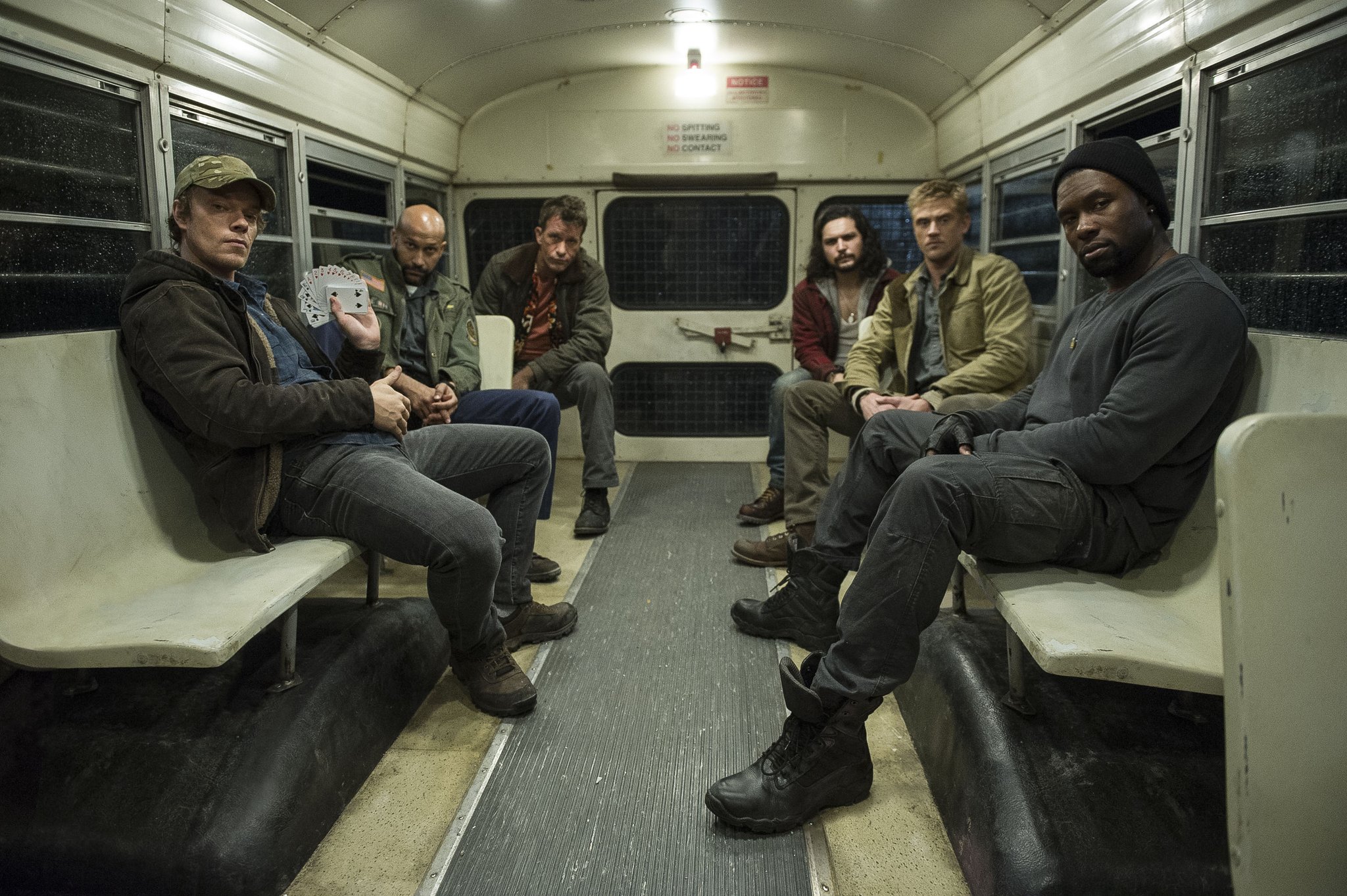
In the late 1980s, Thomas Jane snuck into his local cinema to watch Predator with some friends. Still in his early teens, he was too young to see Arnold Schwarzenegger’s R-rated carnival of bullets, aliens and gore, but like a lot of kids, he simply bought a ticket for a different movie and then crept round to the screen where Predator was playing. It was, Jane tells us as he sits with us between takes, “one of those great, seminal movies of our childhood.”
Not that Jane – now an actor, famous for roles in such films as Boogie Nights, The Mist and The Punisher – seems overawed by the chance of appearing in a franchise he lists alongside Alien and RoboCop. “They were pretty special,” Jane says with a shrug, “so now they’ve made a whole bunch of Predator movies, and most of them suck. So we’re reinventing the franchise.”
When asked how he accounts for the ongoing popularity of the Predator series, his response isn’t what you’d necessarily call on-message.
“It’s the great design,” he says, mildly. “You know, Predator’s not a great film or anything. It’s a bunch of fuckin’ guys in the jungle being chased around by an invisible thing that, when you finally see it, it’s a really cool alien design. It’s the mystique of those creatures, you know?”
What Jane seems most enthusiastic about, though, is the premise behind this new Predator movie, and the tone Shane Black’s going for.
“He’s trying to create a sense of realism,” the actor says, “but also a sense of humour with the thing, you know? It’s a little irreverent. It’s also scary, with a lot of terrific action. I love the idea of taking a bunch of lunatic, misfit veterans who were used up by the military and thrown away – they can’t even get their meds on time, or get proper care – we take these guys and pit them against a threat from outer space. I think it’s great.”
Jane plays a character named Baxley, a member of McKenna’s mercenary outfit who, much like the rest of them, is mentally scarred by his wartime experience. He’s less dangerous-sounding, however, than Keegan Michael-Key’s character, Coil – another ex-soldier who, Jane confides, “had a friendly fire incident where he fired on his own troops and killed a bunch of guys. In fact, he killed all of his guys except for one, and that one guy was me.”
“There’s sort of a love-hate relationship between the two of us,” Jane says, his face deadpan. “I really want to kill him in his sleep, but I also feel that we have a connection – we need each other in a way. He needs redemption from me. I just want to kill him.”
It’s hard to tell, as Jane shifts in his chair and talks wryly about his latest movie, whether he’s still channelling a hint of his Baxley character. His tone is such that, when he exudes a certain level of world-weariness, we can’t quite tell whether he’s being serious or not. He talks thoughtfully about the connection between the original Predator and the US military’s experiences in the jungles of Vietnam, and how the creature embodies our darker human instincts – our drive to kill, our inability to set aside the predatorial, animal side of our nature.
“That’s probably why the creature endures,” Jane says, before adding with a thin smile, “Unfortunately.”
Then there’s the moment where Jane talks about the end of the world.
“These are the last movies before the apocalypse,” Jane says, unprompted. “You can tell. They’re getting bigger and bigger, the explosions are getting bigger. This is the last gasp here, fellas.”
Jane’s apocalyptic musings draw a ripple of nervous laughter.
“It seems funny,” Jane says, looking us in the eye, “but you won’t be laughing in 10 years. It’s true. It’s kind of sad, you know? But we don’t learn the lessons. A lot of films try to make that point – a lot of artists and writers and great books. You find this message over and over, especially in the arts, is that we’re not learning lessons that we’re not supposed to learn. We’re digging the ditches. Whistlin’ Dixie and digging our own graves. It’s fun. So why not kill some aliens in the process, right?”
Well, quite.
“I don’t think the choppers are coming”
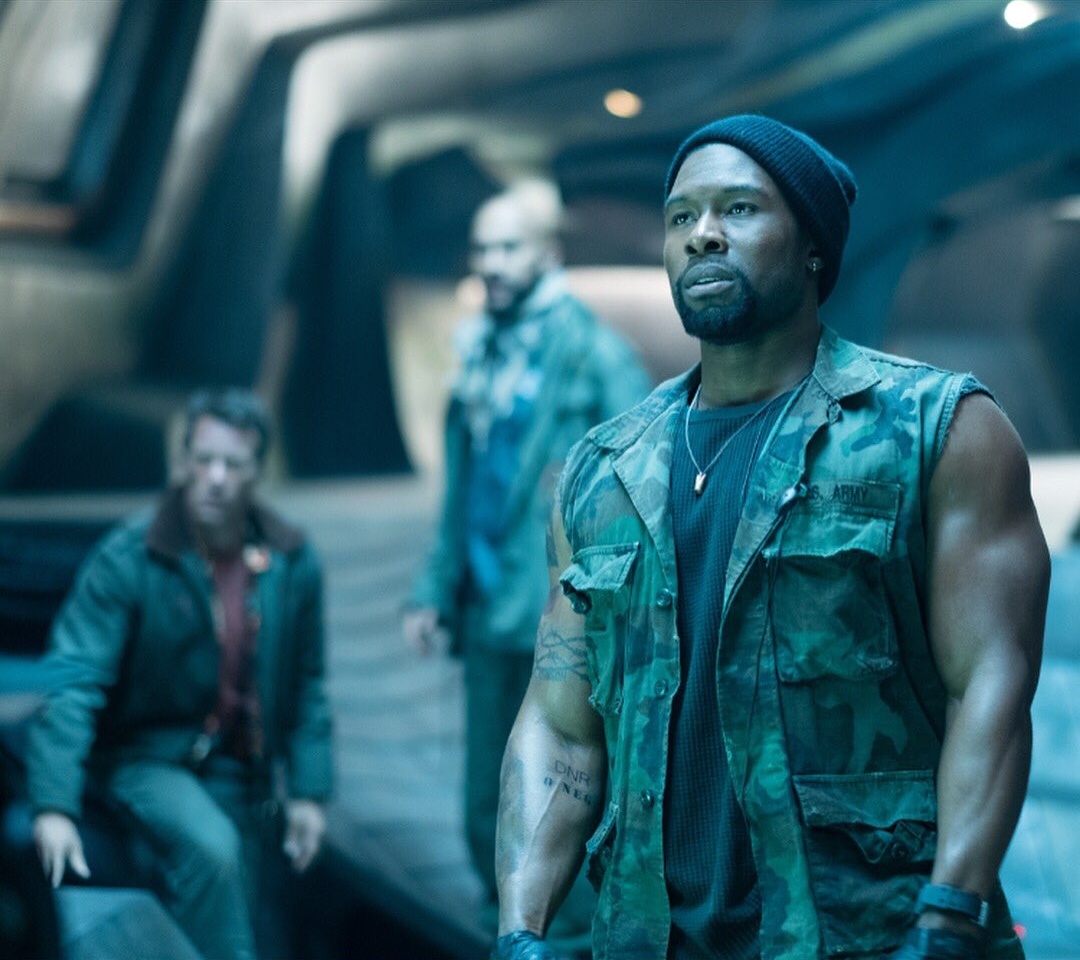
One of the reasons why expensive films cost as much as they do is because of all the preparation it takes just to get a take set up; what can amount to a minute or even a few seconds of screen time in a finished movie can take days to actually shoot. Movie-making may sound like a dream job, but from the outside, it can also look fiddly and occasionally frustrating.
Later in the day, we watch Black and his crew work on a complicated-looking dialogue scene, which takes place inside the Predator ship, called the Ark – it’s all weird buttons and complicated-looking controls. The scene’s complicated because of the sheer number of actors involved: here, the three leads – Munn, Tremblay, Holdbrook – are joined by the rest of the Lunatics (among them Augusto Aguilera and Thomas Jane), plus a mysterious military-type character named Woodhurst, played by the great Edward James Olmos.
Olmos is wrapping his tongue around a complicated chunk of exposition, while in each take, Thomas Jane improvises different vocal tics for his unhinged character, Baxley. Actors are trying to hit their marks in a relatively confined space as the cameras move around; all the while, they’re trying to recite verbose dialogue that we can’t repeat here for fear of spoiling things.
Black’s on hand, wearing a red hat and a body warmer, making dialogue suggestions and working out camera and actor positions. There’s a hint of tension in the air, which is punctured only slightly when Olmos trips over a bit of the set in the middle of the take. “It’s all gonna come together,” Black reassures them. “Gonna be sweet, gonna be fine.”
After another run-through on camera, the decision’s made to take a break – which, excitingly, means we’re allowed to roam the Ark for ourselves. The Ark interior is all swooping clean lines and red LED lighting – if you can remember the ship from Flight Of The Navigator, you’ll have an idea of what it looks like. Production designer Martin Whist says he carved the thing himself, with the finished design built from stryofoam.
The ship’s built on a raised platform, apparently because there are some sequences that will require things (or maybe actors) falling some distance. Altogether, Whist reckons the ship’s about 100 feet long and 100 feet high – a big alien craft by most yardsticks. There are other bits of the ship being built, too, it seems; we see an angular, possibly extraterrestrial corridor off to one side somewhere, and a huge metallic door which matches the finished ship interior.
“If the paint looks as though it’s still wet,” one crewmember tells us, “That’s because it probably is.”
“Predators tend to go forwards, not backwards”
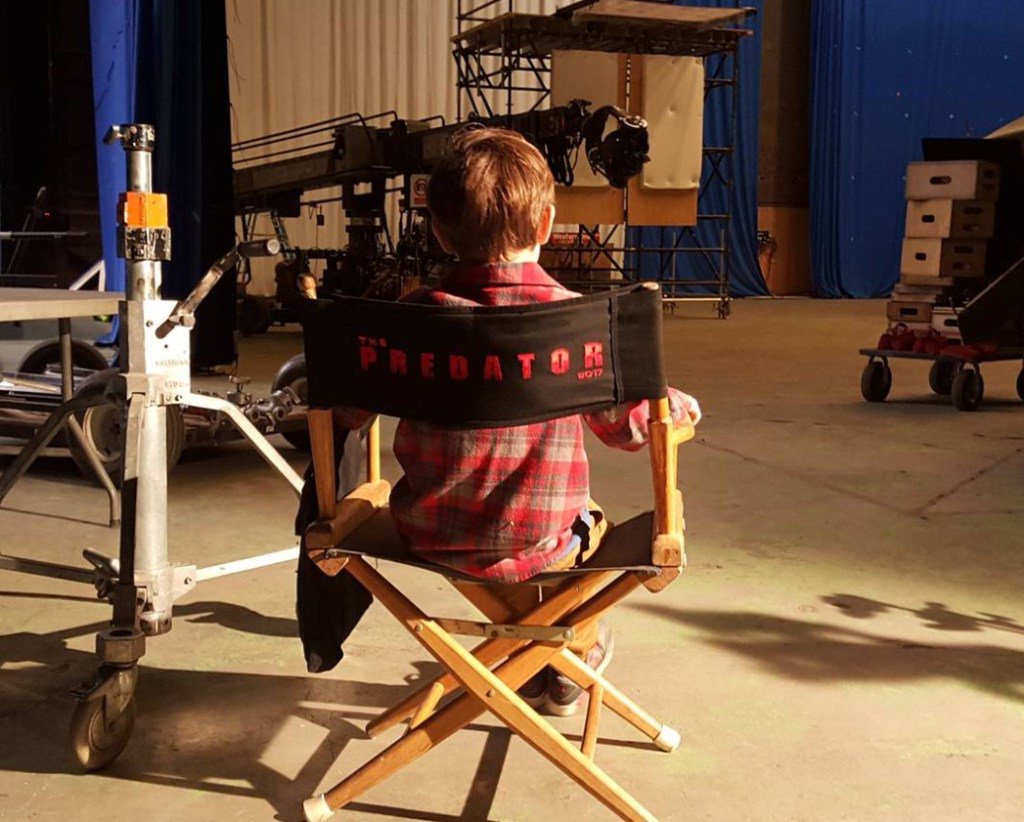
As our day on set comes to an end, there’s still a long way to go on The Predator’s shoot – the movie still has several days left of filming. But while we can’t know how Shane Black’s new movie will measure up to a much-loved 80s classic, it’s encouraging that The Predator is being made by people who have a connection to the original – whether they were actually in it, like Black, worked behind the scenes, like Gillis and Woodruff, or just loved it as kids, like so many of the actors we met.
With all those invisibility effects, heavy costumes and stunts, Predator movies are tough to make. But from the little shreds we’ve seen, the alien big-game hunter looks just as he did 30 years ago: imposing, scary, and unspeakably cool.
To quote one ominous-sounding line uttered by Edward James Olmos: “We’re headed for a war…”